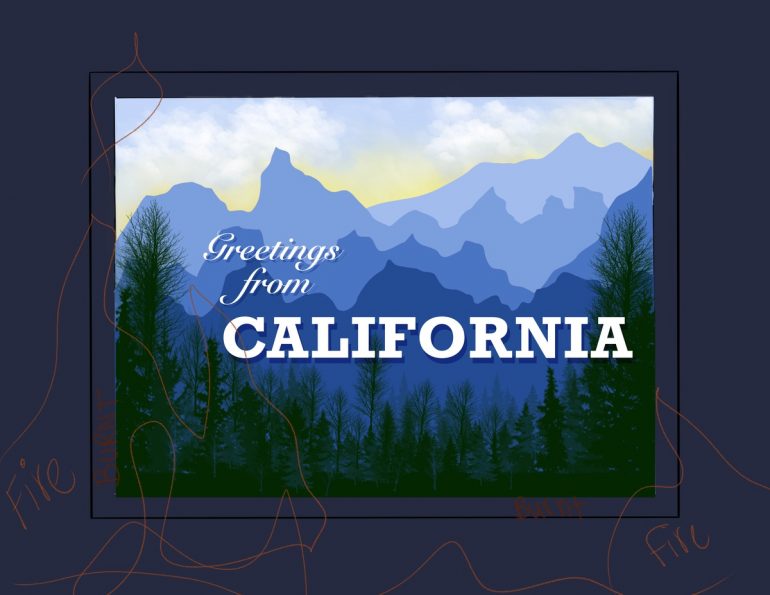In just minutes, entire homes are ravaged and innocent lives are turned upside down by a single culprit. All that is left behind are ashes. The name of this criminal remains plastered in news headlines year-round: “Relentless Wildfire Continues to Scorch the West.”
The criminal nature of wildfires is likely to be obvious to people in our modern society. Every year, people are forced to face the harmful effects of fires: smoke inhalation, massive financial damage, homelessness, and devastating deaths. Unfortunately, the frequency of wildfires in the United States continues to increase each year, and the U.S. Forest Service projects that the dangers posed by climate change will only exacerbate these wildfires.
Throughout California, firefighters work tirelessly to prevent and contain this beast. According to the U.S. Forest Service guidelines, firefighters use fire retardant to reduce the intensity and rate of wildfires as well as hand tools to dig fire lines. With the death and destruction that wildfires cause, there seems to be no question that uncontained fires have the capacity to cause harm. However, Indigenous tribes in California hold a different perspective; they view fire as an ally, a powerful force that can be compromised with. These tribes take advantage of the vital role that fires play in our ecosystem by proposing a different solution to containing wildfires: fighting fire with fire.
Indigenous tribes employ a practice called “prescribed burning,” a technique in which small, contained fires are intentionally set in areas prone to wildfires in order to reduce surface fuel levels and vegetation, according to a paper in the Ecological Applications journal. Surface fuels include natural materials found in forests, such as dry grass and twigs, which allow fires to easily ignite and spread. Prescribed burns consume these surface fuel levels, consequently preventing future wildfires from burning as intensely.
Before the colonization of North America, native people successfully managed large areas of land with such intentional burns; however, the marginalization of these tribes after colonization buried years of knowledge about managing wildfires. Margo Robbins, a member of the Yurok tribe of California, explains that native people were forbidden from conducting prescribed burns, which were an important cultural practice for a tribe. Furthermore, in 1911, the U.S. Forest Service prioritized the very opposite of prescribed burning: preventing fires of any kind. This idea prompted a series of federal policies that allowed forests to grow denser, increasing the risk of wildfires and further villainizing fires in the public eye. More importantly, the U.S. Forest Service took on a reactive approach rather than a proactive one.
Contrary to the U.S. Forest Service’s belief, fires play an important role in facilitating ecological balance. As described in a paper published in the Ecological Society of America, fires increase plant biodiversity through evolutionary and ecological processes. When fires take place, they create new habitats for plant species with increased resources and decreased competition with other species. Forcing these species to adapt to new habitats allows them to evolve over time in order to survive in the conditions created by the fires. Ecologically, fires create large, open spaces by burning vegetation, which creates open ecosystems. In open ecosystems, plant species can interact more dynamically with different organisms and even relocate to conditions that are more environmentally suited to their development. Therefore, it is important to recognize the crucial role that fires play in the life cycle of forest ecosystems.
The rapidly worsening wildfire conditions in California prompted CALFIRE, the state’s department of forest and fire protection, to look towards the fire management expertise of Indigenous people. In 2013, the Yurok tribe collaborated with CALFIRE to execute a small prescribed burn on Yurok ancestral lands. This collaboration was an important stepping stone to further the efficacy of sanctioned fire management. By 2014, a training program that brought together firefighters and members of the Yurok tribe was created to establish the legal requirements necessary to regularly practice prescribed fires. Joining forces can not only consolidate traditional and modern knowledge about fires, but also allow the Indigenous people of California to reclaim prescribed fires as an important part of their culture.
Continuing to incorporate the expertise of Indigenous fire experts into modern day fire management techniques may just be the key to improving current wildfire control tactics. According to a PBS news article, CALFIRE is now committed to burning a half-million acres in California by 2025 in anticipation of future wildfires. Wildfires are rapidly increasing and resources to stop them are depleting, so there is still much work to be done. However, if the collaboration between state organizations and native tribes continues, we can gradually turn fire from a foe into a friend.
